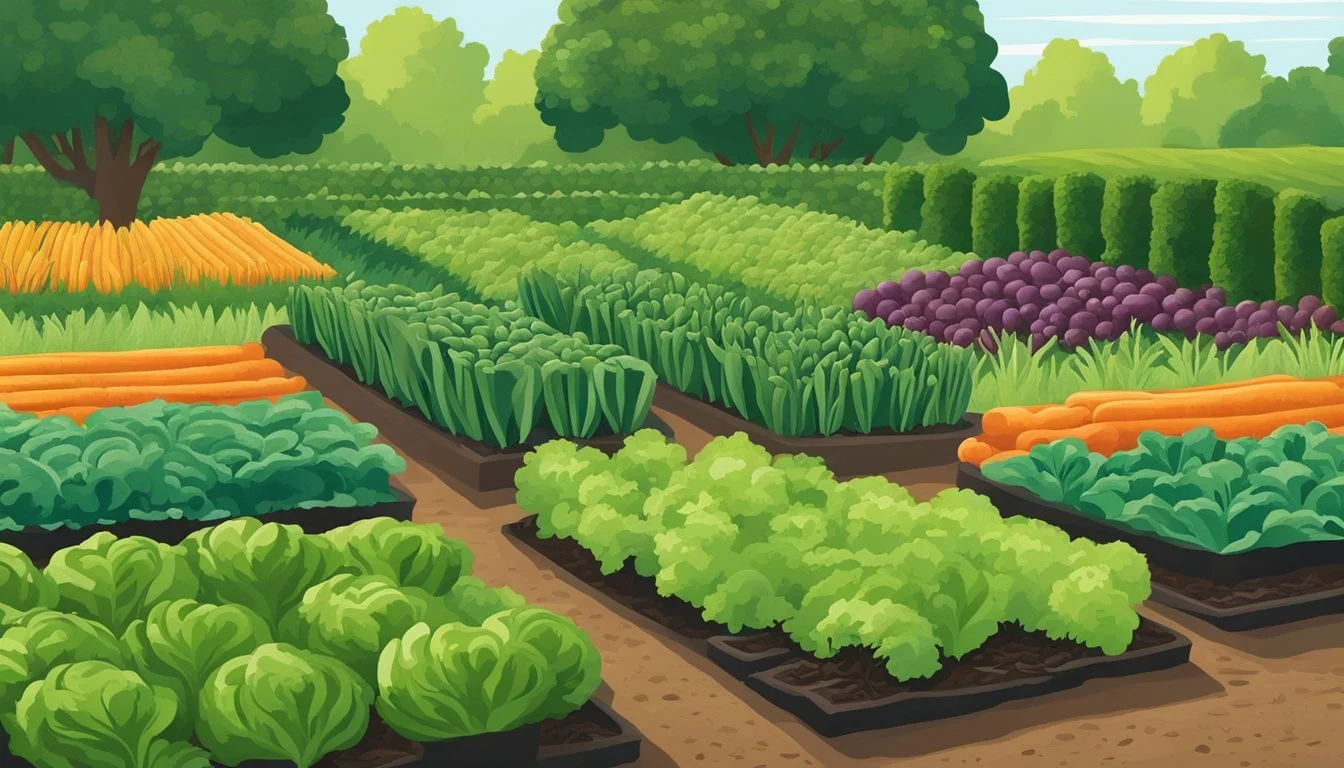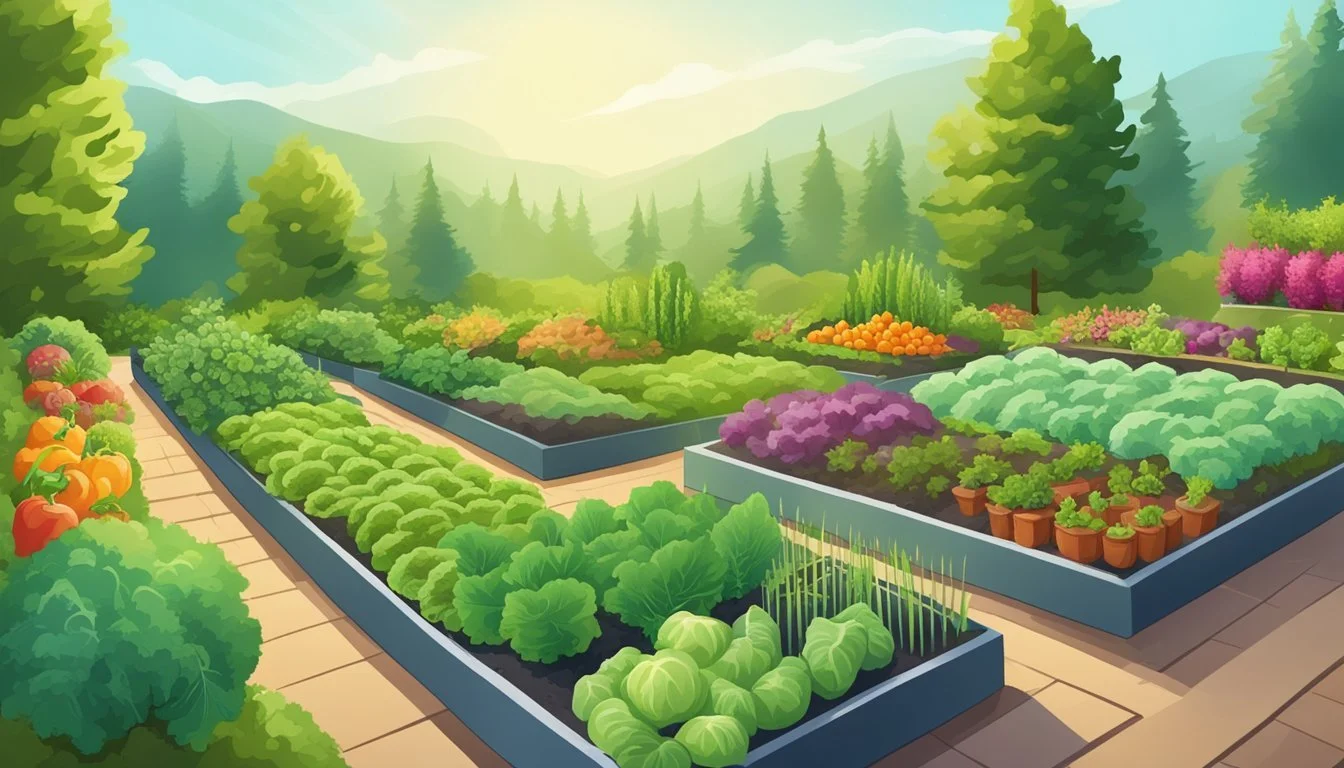Vegetable Gardening in Washington
A Practical Guide for Home Growers
This Article is Part of Our Guide on Vegetable Gardening by State
Vegetable gardening in Washington offers a wealth of opportunities for both novice and seasoned gardeners. With its unique climate and diverse regions, Washington state is well-suited for a range of vegetables that thrive in various seasons. Cold-hardy vegetables, such as lettuce, are particularly well adapted to Washington's cooler spring and fall months. The ability of some plants to grow in colder conditions, sometimes even in the presence of frost or snow, allows Washington gardeners to extend their growing seasons.
The state's environment, characterized by distinct wet and dry areas, dictates the types of vegetables that can be grown and the methods used to cultivate them. Gardeners in Washington can benefit from a robust agricultural community and extensive resources, such as Washington State University's guides on vegetable gardening. These resources promote best practices, such as appropriate planting times, soil preparation, and integrated pest management.
Washington's rich soil in many areas, coupled with environmental consciousness among its residents, often leads to practices that conserve natural resources and protect water quality. Gardeners can craft a bountiful and beautiful garden by selecting the right vegetables for their region and managing their garden space efficiently. Whether in a sprawling backyard or a small urban plot, vegetable gardening in Washington can be a rewarding venture throughout the growing season.
Planning Your Vegetable Garden
A successful vegetable garden in Washington begins with careful planning and consideration of several critical factors, ranging from site selection to managing the unique climate of the Pacific Northwest.
Selecting the Right Location
A garden starts with location. Choose an area that receives at least six hours of sunlight daily and provides good drainage. Raised beds can optimize drainage and are excellent for accommodating root vegetables like carrots and beets. In small spaces, consider vertical gardening or container gardening.
Choosing Vegetables to Grow
Washington gardeners enjoy a variety of vegetables: leafy greens like lettuce and spinach, cruciferous kale and broccoli, legumes such as peas, pole beans, and bush beans, and tasty roots like radishes and carrots. Summer favorites include tomatoes, peppers, cucumbers, zucchini, and squash.
Understanding Washington's Climate
The climate varies, with cool summers and the possibility of extreme heat. Familiarize with the Pacific Northwest climate to maximize your garden's potential.
Garden Layout and Design
Strategically design your garden to maximize space and sunlight exposure. Companion planting can help in pest management, and mulching conserves soil moisture while reducing weeds.
Soil Preparation
Soil in Washington can range from sandy to heavy clay soil. Amend it with compost or organic fertilizer to improve fertility and structure. Soil conditions should encourage healthy plant growth.
Hardiness Zones and Timing
Washington is divided into growing zones from zone 4 to zone 9. It's essential to plant according to local hardiness zones and time plantings to match the growing season—cool temperatures in spring and fall for cold hardy vegetables and warmer summer months for others.
Seeds vs. Transplants
Some vegetables like lettuce and spinach can be easily started from plant seeds directly in the garden, while others, such as tomatoes and peppers, are better off beginning as transplants to ensure a longer growing period.
Pest Control and Management
Common pests, such as aphids, can be managed with organic methods. Regular inspections and interventions like hand-picking can often prevent serious infestations.
Watering and Irrigation
The key to watering is consistency—keeping the soil moisture even. Drip irrigation is an efficient system for maintaining an optimal watering schedule, essential for thriving vegetable plants.
Planting and Maintaining Your Garden
Achieving a flourishing vegetable garden in Washington requires specific planting techniques and dedicated garden maintenance, including vigilant disease and pest prevention. Successful gardeners also establish regular watering routines, take steps to optimize garden health, and adjust their practices with changing seasons.
Planting Techniques
Creating a productive vegetable garden starts with proper planting. Utilizing raised beds can improve drainage and extend the growing season due to their ability to warm up faster than in-ground beds. Planting in areas that receive direct sunlight for at least six to eight hours a day is crucial for most vegetables. Trellises can be beneficial for supporting climbing plants like cucumbers and peas, maximizing space efficiency.
Direct Sowing: Some vegetables, such as radishes and carrots, do best when sown directly into the soil.
Transplants: For slower-growing vegetables like tomatoes, starting indoors and transplanting after the last frost can yield better results.
Garden Maintenance
Regular care keeps a vegetable garden productive. Mulching conserves moisture and controls weeds, while fertilizing with organic fertilizer or compost provides necessary nutrients. Pruning certain plants can improve air circulation and yield.
Soil Conditions: Amend soil with compost or aged manure to enhance fertility and structure.
Weed Control: Hand-pulling weeds or using mulch can prevent weeds from competing with vegetables for nutrients.
Disease and Pest Prevention
A proactive approach to managing pests and diseases can save a garden from ruin.
Companion Planting: Planting certain plants together can naturally repel pests or attract beneficial insects.
Inspection: Regularly inspect plants for signs of pests and diseases to tackle problems early.
Watering Routines
Proper watering is essential for vegetable gardens. Drip irrigation systems deliver water directly to the root zone, reducing waste and minimizing leaf wetness that can lead to diseases.
Early Morning Watering: Encourages efficient water use and allows foliage to dry out, reducing disease risk.
Optimizing Garden Health
Beyond basic care, garden health can be optimized by:
Crop Rotation: Rotating crops in the garden can prevent soil depletion and interrupt pest cycles.
Soil Testing: Periodically testing soil can inform adjustments to pH and nutrient levels, ensuring optimal growing conditions.
Seasonal Considerations for Planting
Washington's climate is characterized by cool summers and potential cold weather in winter, which influences planting schedules.
Cold Weather Crops: Plants like kale and Brussels sprouts (how long do brussels sprouts last?)can thrive in cool temperatures and can be planted early in the season.
Cool Summers: Crops tolerant of cooler summer temperatures, such as lettuce and spinach, excel in Washington's climate.
By adhering to these techniques and maintenance practices, gardeners can significantly improve the likelihood of success in their vegetable gardens. Regular attention and adaptation to the evolving needs of the garden throughout the growing season are the cornerstones of a bountiful harvest.
Harvesting and Storing Your Vegetables
Proper harvesting and storage techniques are crucial for maintaining the quality and extending the shelf life of your produce. Whether you're growing leafy greens, root vegetables, or various fruits in Washington's unique climate, understanding when and how to harvest, as well as the appropriate storage procedures, will ensure that your garden yields the best possible results.
Best Practices for Harvesting
When harvesting vegetables, it's important to use the right tools and techniques to avoid damaging the plants or produce. Sharp scissors or pruners are ideal for cutting stems cleanly without causing stress to the plants. Vegetables like lettuce and kale can be harvested leaf by leaf to promote continuous growth. For root crops, such as carrots and potatoes, use a garden fork to loosen the soil around the plant to avoid breaking the vegetables as they are pulled.
Determining Ripeness and Peak Flavor
Identifying the optimal time to harvest can greatly influence the taste and longevity of your produce. Most vegetables are best picked when they are firm and have reached their full color. For example, tomatoes should be harvested when they are evenly red and slightly soft to the touch. Leafy greens, like lettuce, are most flavorful when harvested in the cool morning hours, which preserves their crispness and reduces wilting.
Post-Harvest Handling
After harvesting, proper handling is key to preserving freshness. Vegetables should be cooled immediately to reduce respiration rates and slow down decay. Delicate fruits and vegetables benefit from being kept in high humidity to prevent dehydration. Washing produce before storage can sometimes promote mold growth; instead, brush off any soil and only wash right before use. Store different types of produce separately to prevent faster-ripening items from affecting the longevity of others.
Extending the Growing Season
Washington's hardiness zones allow for an extended growing season for certain cold-tolerant crops. Vegetables like kale, collards, and brussels sprouts can survive cool temperatures and even a touch of frost, which can sweeten their flavor. Utilizing techniques like mulching, row covers, or cold frames can protect plants from chilly weather and extend the harvest season into the early winter months.
Community Involvement and Resources
Community involvement in vegetable gardening provides a myriad of opportunities for both the novice home gardener and the seasoned grower. Washington State offers resources and communal spaces that encourage sustainable agriculture and education.
Participating in Community Gardens
Community gardens in Washington facilitate a space for individuals to learn about vegetable gardening while cultivating crops. They not only provide a platform for growing vegetables but also foster a sense of community among participants. By connecting with local extensions like the Washington State University (WSU) Whatcom County Extension, residents can find nearby community garden locations and learn how to get involved.
Educational Opportunities and Workshops
Washington residents have access to various educational resources such as Master Gardener-led workshops and growing guides. The WSU Extension offices offer classes on environmentally sound gardening practices and pest management techniques. Such workshops empower home gardeners to apply best practices in their own vegetable gardens, contributing to both personal and community food security.
Local Gardening Stores and Supplies
Garden stores throughout Washington provide the necessary tools, seeds, and supplies for vegetable gardening. Whether it's a traditional garden store or a specialized nursery, these businesses are invaluable for home gardeners seeking specific items or advice. Shoppers can find a selection of:
Seeds tailored to Washington's climate
Soil and compost options for optimized growth
Gardening tools for maintenance and harvest
Sharing Harvest and Community Engagement
After the growing season, gardeners can share their harvest with the community, thereby enhancing food security and promoting healthy choices. Organizations within Washington encourage gardeners to donate excess vegetables to food banks or participate in community harvest events. This engagement deepens relationships within the community and emphasizes the importance of local, fresh produce.
Expanding Your Vegetable Garden
Expanding a vegetable garden in Washington involves introducing new varieties, incorporating perennials, and adopting inventive gardening methods tailored to the local microclimates.
Introducing New Vegetable Varieties
Gardeners should consider selecting cool-season crops that are well-suited for Washington's mild winter climate. Vegetables like broccoli, Brussels sprouts, cabbage, and cauliflower not only thrive due to the cooler temperatures but also diversify the garden offerings. Experimenting with different root vegetables such as carrots, beets, and turnips can enhance a garden's yield.
Advancing to Perennial Plants
Perennials are a strategic choice for a low-maintenance garden, providing a yearly harvest with less effort after the initial planting. Examples include asparagus and artichokes (What wine goes well with artichokes?), which are suited to the Pacific Northwest climate. The incorporation of perennials can offer a reliable and long-lasting section within a garden landscape.
Innovative Gardening Methods
Vertical gardening and container gardening are innovative solutions for space constraints and can lead to a more productive vegetable garden. Vertical structures support the growth of vining plants like cucumbers and pole beans, while containers allow for mobility and better soil control, ideal for lettuce and herbs.
Vertical Garden Examples:
Cucumbers
Pole beans
Peas
Container Suitable Vegetables:
Lettuce
Herbs
Tomatoes
Gardening in Unique Local Microclimates
Washington's varying local microclimates necessitate a tailored approach to gardening. In western Washington, gardeners often deal with cool summers, whereas areas like Seattle may experience slightly warmer conditions. Understanding one's microclimate can lead to choices that maximize sun exposure and protection from the Pacific Northwest's frequent rain, leading to a bountiful harvest of best vegetables to grow in that specific area.






